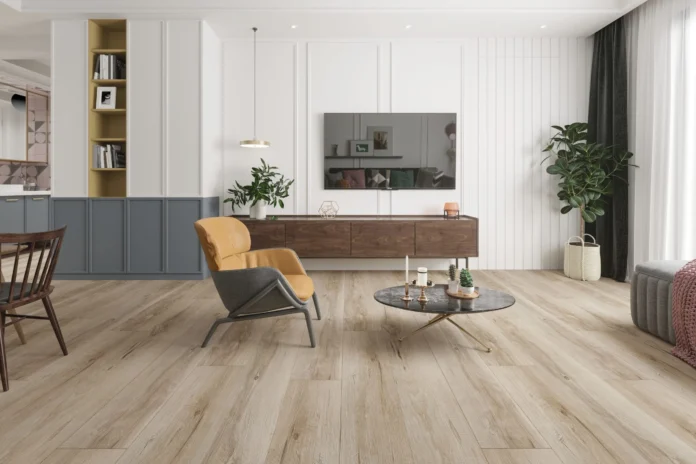When it comes to choosing flooring for your home, you’re faced with a multitude of options, each with its own set of advantages and considerations. Vinyl flooring, however, has steadily gained popularity as a practical and stylish choice.
With its durability, affordability, versatility, and aesthetic appeal, vinyl flooring has become a top pick for homeowners looking to enhance their living spaces. In this article, we’ll delve into the world of vinyl flooring, exploring its benefits, types, design options, and why it’s a smart choice for your home.
Benefits of Vinyl Flooring
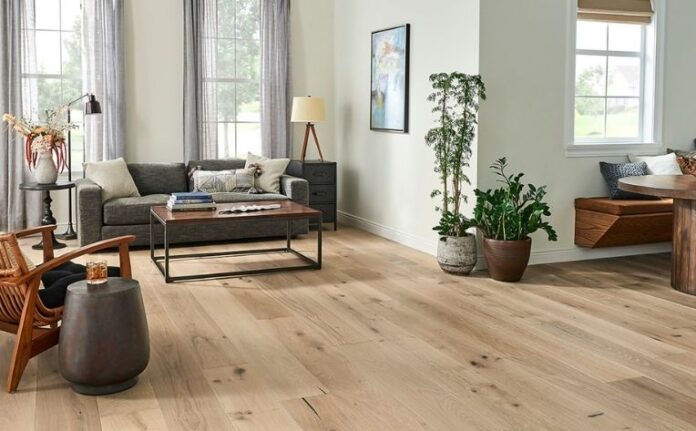
Vinyl flooring offers numerous benefits that make it an attractive option for homeowners:
1. Durability
Vinyl flooring is known for its exceptional durability. It can withstand heavy foot traffic, making it suitable for high-traffic areas like hallways, kitchens, and family rooms.
2. Water Resistance
Vinyl is inherently water-resistant, making it a practical choice for bathrooms, kitchens, and laundry rooms. It can handle spills, splashes, and moisture without warping or damage.
3. Affordability
Vinyl flooring is often more budget-friendly than many other flooring options, making it an excellent choice for homeowners looking for cost-effective solutions without compromising on quality.
4. Easy Maintenance
Vinyl is easy to clean and maintain. Regular sweeping and occasional mopping with a mild detergent are typically all that’s needed to keep it looking its best.
5. Versatility
It comes in a wide range of styles, colors, and patterns, allowing you to achieve the look you desire. It can mimic the appearance of natural materials like wood, stone, and tile.
6. Comfort
This is soft and comfortable underfoot, providing a more cushioned surface compared to hardwood or tile. This makes it a comfortable choice for bedrooms and playrooms.
7. Installation
Vinyl flooring is relatively easy to install, whether you choose sheet vinyl, vinyl planks, or vinyl tiles. It’s often available in DIY-friendly formats, reducing installation costs.
Types of Vinyl Flooring
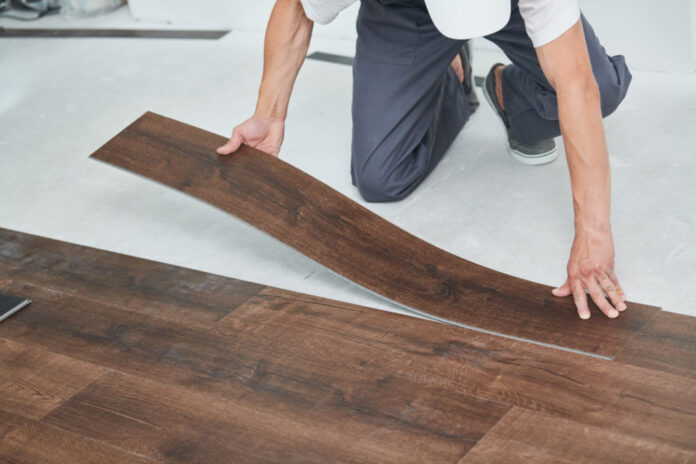
There are three primary types of vinyl flooring to choose from:
1. Sheet Vinyl
Sheet vinyl is a continuous roll of vinyl flooring that can be cut to fit your room’s dimensions. It offers seamless installation and is an excellent choice for high-moisture areas like bathrooms and kitchens.
2. Vinyl Plank Flooring
Vinyl plank flooring mimics the look of hardwood flooring but offers the durability and water resistance of vinyl. It comes in planks that can be installed with or without adhesive, depending on the type.
3. Vinyl Tile Flooring
Vinyl tile flooring replicates the appearance of ceramic or stone tiles. These tiles can be easily installed with adhesive or as peel-and-stick tiles, making them a convenient choice for DIY projects.
Design Options
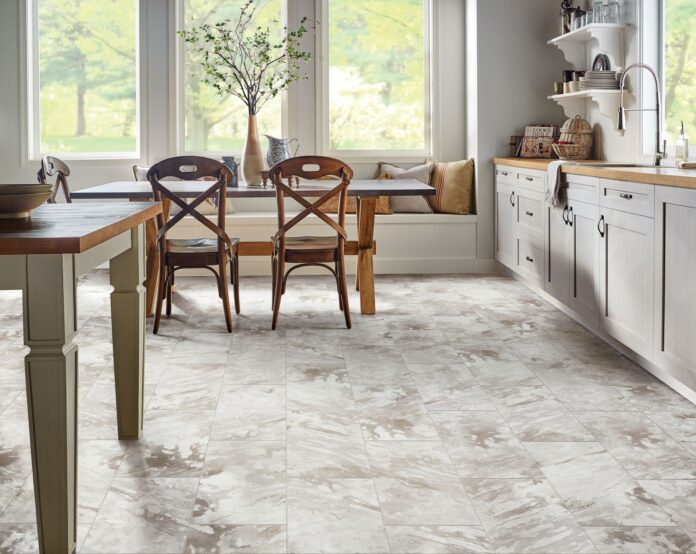
Vinyl flooring offers a wide range of design options to suit your aesthetic preferences:
1. Wood-Look Vinyl
Vinyl planks and tiles are available in various wood grain patterns and colors, allowing you to achieve the warmth and charm of hardwood flooring without maintenance.
2. Stone-Look Vinyl
Vinyl can mimic the appearance of natural stone, such as marble, travertine, and slate. This provides an elegant and sophisticated look for your home.
3. Tile-Look Vinyl
Vinyl tiles come in a variety of sizes and can replicate the look of ceramic or porcelain tiles. You can create intricate patterns and designs using vinyl tiles.
4. Color and Patterns
Vinyl flooring is available in an array of colors and patterns, from classic neutrals to bold and vibrant designs. This flexibility allows you to personalize your space.
5. Texture and Finish
Choose between a matte or glossy finish, depending on your preference. Some of the options also feature embossed textures that mimic the feel of natural materials.
Installation and Maintenance
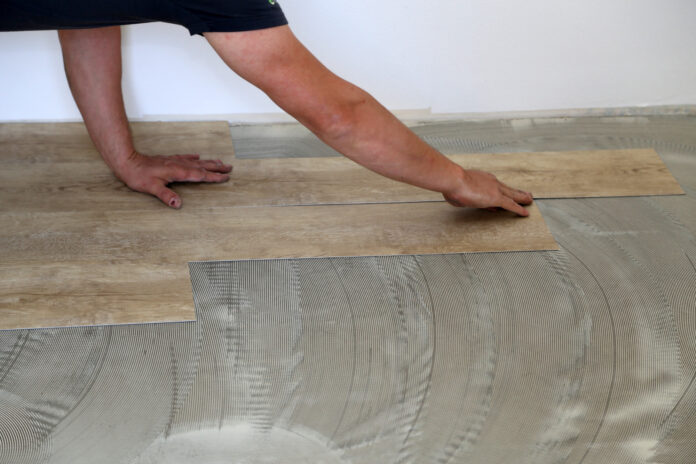
Installation of vinyl flooring varies depending on the type you choose. Sheet vinyl often requires professional installation to ensure a seamless fit. Vinyl planks and tiles can be installed with or without adhesive, making them suitable for DIY projects. It’s crucial to follow the manufacturer’s installation guidelines for the best results.
Maintenance of vinyl flooring is relatively easy. Regular sweeping or vacuuming removes dust and debris. Mopping with a mild detergent solution is suitable for deeper cleaning. Unlike hardwood or natural stone, vinyl does not require periodic sealing or refinishing, saving you time and maintenance costs.
This is a practical and stylish choice for homeowners seeking durability, affordability, and versatility in their flooring options. Whether you prefer the warmth of wood, the elegance of stone, or a bold and vibrant design, vinyl flooring offers numerous design possibilities to enhance your living spaces. Its water resistance, ease of maintenance, and comfortable feel underfoot make it an excellent choice for various rooms in your home. Consider vinyl flooring for your next project, and experience the benefits of a durable and visually appealing floor that complements your lifestyle and enhances your home’s value. Contact us for more information on Victorian style vinyl flooring.
One of vinyl flooring’s standout features is its remarkable durability. It can withstand heavy foot traffic, making it an ideal choice for high-traffic areas such as kitchens, hallways, and commercial spaces. Vinyl is also water-resistant, which makes it suitable for bathrooms and basements where moisture can be a concern. Additionally, vinyl flooring is easy to clean and maintain, making it a practical choice for busy households.
Another advantage of vinyl flooring is its wide range of design options. With advances in technology, vinyl can mimic the look of natural materials like hardwood, stone, and tile. You can achieve the aesthetic appeal of these premium materials without the high cost and maintenance associated with them. Vinyl flooring also comes in an array of colors, patterns, and textures, allowing you to express your unique style and create the atmosphere you desire.
Installation is a breeze with vinyl flooring, as it can be installed over most existing subfloors, including concrete and plywood. It can be glued down, clicked together as floating planks or tiles, or even loose-laid, depending on the type you choose. This versatility saves both time and money during the installation process.
In conclusion
Vinyl flooring has become a go-to choice for homeowners and businesses seeking an affordable, durable, and stylish flooring solution. Its ability to withstand wear and tear, resist moisture, and offer a wide variety of design options make it a practical and aesthetic choice for any space. Whether you’re looking for the warmth of wood, the elegance of stone, or a unique pattern, vinyl flooring can deliver both the look and performance you desire. Consider vinyl flooring as a top contender for your next flooring project

